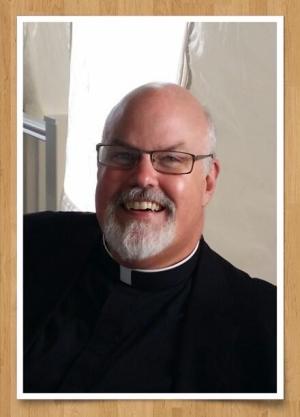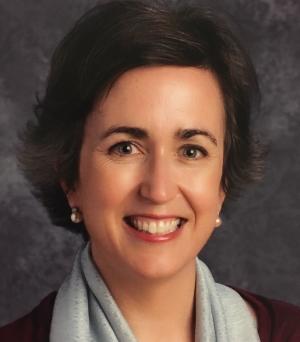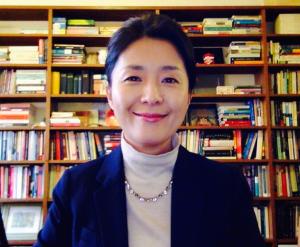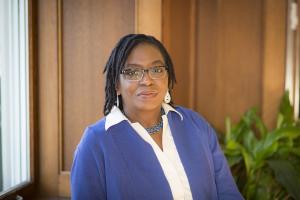Resources
With the peculiar upheaval of COVID-19, and the recent, flagrant events of racist violence, what competencies are needed by institutional leadership? What does it mean to lead change in this moment of volatility? What courage is necessary? What approaches in higher education will bring new stability in a more equitable society? Dr. Nancy Lynne Westfield hosts Rev. Stephen Lewis (FTE - Forum for Theological Exploration) and Rev. Matthew Williams (Interdenominational Theological Center).

Is the study of theology worth it? That’s a question you and I might pose to our students at the beginning of every semester. At times, we may have to answer this query for ourselves. At the beginning of each semester, I presume this is a question that students have, particularly because at my university students are required to take three theology courses. The first day of theology classes, then, I offer a value proposition. (Now, mind you, I generally teach moral theology classes primarily to business and pharmacy students.) I tell my students that this course may not position them for their ideal job in a corporation or biomedicine, but that a theology course can help students think, write, and speak with a depth and breadth they before had not known. The subsequent question every term is, “but how will that help me advance in my career?” These developed skills, I tell them, will aid them in living out the challenging and, perhaps, painful realities of life. That has never been truer than in these days of Covid-19. One of the first topics I teach is “narrative.” I invite my students to consider what the foundational stories for different religions are. Conversations extend from the metanarratives that undergird traditional monotheistic religions to Rastafarianism, Wicca, and Mormonism. These class days tend to be lively ones as we move into discussions of the Branch Davidians and the Westboro Baptist Church. Good narratives mature over time as profound experiences impact and challenge them. My parents’ generation had Martin Luther King’s “I Have a Dream” speech on the steps of the Lincoln Memorial, the Second Vatican Council, the assassination of John F. Kennedy, and the rise of Fidel Castro’s Cuba. Honestly, it made me jealous. I wanted stories to add to my collection, but could not imagine having any of such historical impact as they had. How young and naïve I was! GenXers and I have experienced stories that have forced us too to reevaluate the foundational narratives in which we were grounded. The students in front of me, now on my computer screen, were curious about my generation’s stories. Mind you, when I first started teaching, as I suspect all of us are/were, we are/were our students’ older sibling. Now, I could be their parents and for that reason, they are curious. When asked, I speak of how marginalized groups and their allies consistently have fought for equality, particularly LGBTQIA+ citizens, communities of color, and immigrants; seemingly endless wars in Viet Nam, the Gulf, Afghanistan, and Iraq; governments, including the United States, having a wide range political scandals; 9/11; and, of course, the information technology revolution. For some reason or another, they are fascinated, and I suspect hungry like I was when I was younger to have their own stories. While some have alluded to the global digital transformation in their lives, there has never been a clear consensus as to what might unite GenZers in a common narrative. Now, there is. They get it. Students recognize that they must understand the profound effect this global health crisis has had on them, and on their narrative. For those who have been grounded in an understanding of who and what God is for them, they will have additional work that may take them places about they least expected to go. What will be required is what the study of theology provides: some deep thinking, critical writing, and clarity in speaking.
What will it take to teach toward racial justice and away from white supremacy? Thinking about ways to incorporate minoritized voices into the entire curriculum. Dr. Nancy Lynne Westfield hosts Dr. Jill Crainshaw (Wake Forest University Divinity School).

I, like so many, have been flooded with a mixture of emotions during this pandemic and self-isolation. While feelings of fear and anxiety often overcome me, I also have a profound sense of gratitude. I am privileged to be able to take a step back and ask religious questions those deep questions of meaning and value–with fellow religious educators. It is from phone conversations in isolation that Dr. Kathleen O’Gorman and I came to wonder what is this emergent curriculum, or “curriculum of pandemic,” that has descended upon us all, teaching us? What might we learn and how we are we called to respond in meaningful, educative ways? The first place Kathleen and I thought to process this emergent curriculum was with our learning community, to learn from this pandemic with our students and alums. We invited a small group of about 10 people, all of whom were enthusiastic about this gathering, into a process of introspection and learning. It was apparent from our initial correspondence leading up to and during our first session that we all want to feel connected in some way right now. This affirmed for me the need not just for community, but to create an intentional learning community. I –we– longed for a “community of conversation”–to connect and make meaning together. For me, the calling to teach means both teaching and learning and this pandemic called my colleague and I to be more intentional about our praxis as teachers and learners together. Kathleen coined the titled for our virtual sessions “Pandemic Pandemonium.” There is no script or textbook that tells us what we can learn and how we should respond to this global crisis; therefore, we developed a framework of four sessions from which will flow a process of unpacking this curriculum of pandemic. Drawing inspiration from Kathleen’s gifts of music and aesthetics, we framed each one around a different song to evoke our affective sensibilities. In our first session, we set the context for our process of teaching and learning through the pandemic by listening to Sam Cooke sing “A Change Is Gonna Come” set to a video with still images of people standing up for their human rights across the world throughout different moments in history. In sharing our interpretations and insights from this video and song, we discussed how we might connect these historical movements for change to the change emerging before us right now. What change do we want to see from this experience of sheltering in place, from teaching in learning through new modes and mediums, and from recognition the earth is healing itself while we remain still? We concluded that first session by observing how each movement for change in society was a movement towards deeper inclusion. How, then, is this curriculum of pandemic guiding us towards greater inclusivity? This set the tone for our next session, “Go to your room” (something Mother Earth seems to be telling us right now), and the introspection on our feelings and emotions as we withdraw from everyday life. Following John Lennon’s song, “Isolation,” we invited our group to start thinking about how this time away has opened new patterns of living. How have our feelings given rise to new ways of thinking and experiencing the world and how might we help others (those we serve, family, friends) discern the meaning and value of isolation as we are experiencing it? Our third session will reimagine how we “Come Together” (using the Beatles cover song by Gary Clark Jr.), by asking: What now? What is the meaning of all this? What are we learning from gathering in new ways and how does that inform and transform our praxis as religious educators; how does this change in patterns of living call us to rethink our curriculum and praxis towards greater inclusivity? In our final session, we curated a curriculum of closure to be the start of a new beginning. With help from The Beatles again, “Let it Be,” we reflect the meaning of Sabbath during this time as we ask what is Mother Earth telling us? How are we called by Mother Earth to Let it Be? We end our session with a pastoral plan informed by what we learned and how we are called to respond. I hope to return to these reflections as our process unfolds in the coming weeks. In the meantime, I am sharing this experience in developing a process curriculum to invite others, if you have not already begun to do so, to engage in a process of introspection and discernment with your learning community to uncover how your teaching and learning can respond to a curriculum of pandemic.
With the peculiar upheaval of COVID-19, and the recent, flagrant events of racist violence, what competencies are needed by institutional leadership? What does it mean to lead change in this moment of volatility? What courage is necessary? What approaches in higher education will bring new stability in a more equitable society? Dr. Nancy Lynne Westfield hosts Rev. Stephen Lewis (FTE - Forum for Theological Exploration) and Rev. Matthew Williams (Interdenominational Theological Center).

So many of us are struggling to connect meaningfully with our students during this period of unexpected distance. When we don’t get in-person connection time, it’s critical for us to build social and spiritual connection with our students within the online learning space. Giving our students numerical feedback and written feedback on submitted assignments is not enough. While some of my students have a strong network of relationships and resources to sustain them during this time, some do not. I see it as my responsibility to provide some opportunities for students to maintain and deepen connections with each other, themselves, and God. Live check-ins In my live, online classes, we check in with simple questions to start the session. I lean toward the veiled spiritual direction during these times—directing my students’ attention toward where God *is* present, rather than where God isn’t present. For example: • What is working for you in this time of isolation? • For what are you grateful right now? • Where are you finding light within so much darkness? It is my hope that students will take inspiration from each other’s answers. To be clear, this is not to approach the pandemic with a ‘Pollyanna’ point of view, but rather to illuminate that God is still at work, even when we are confronted with challenging circumstances. Student-led prayer on live meetings At the start of each live meeting, there is a student responsible for leading prayer. I instruct my students to choose a video, piece of art, or poem to share with us. We follow it with a minute or two of silent reflection and close with “words directed at God”—in other words, prayer. I provide them with links to prayers and examples of “words directed at God.” We do this in the classroom as well, and I find it to be a nice piece of continuity with the online learning environment. Collect evidence or fun or frivolous “accomplishments” I had my students check in one day with “What’s something fun or frivolous you’ve ‘accomplished’ during the shelter-in-place?” I found it important to clarify the idea of ‘accomplishment’ for this exercise. I explained the capitalistic assumption that we can still produce during this quarantine. This is not that. Rather, what are they doing for fun? Which hobbies are they picking up—either from a while ago or for the first time? We collected video and photographic evidence of their ‘accomplishments’ on a Padlet, a handy, potentially private, online board where students can creatively post their work. Students posted audio clips of music they composed, videos of themselves walking in the woods, and photos of knitting creations or plates of cookies, to name a few. It’s important for us to demonstrate to our students that having fun, letting loose, and being creative are critical parts of being a full human being, especially when we might feel like our usual outlets are cut off for these activities. It is my hope—again—that students might be inspired by others and offer support and encouragement to their classmates’ endeavors. Community building on FlipGrid I like the online learning platform of FlipGrid because it allows me to connect asynchronously with my students face-to-face and voice-to-voice. This is especially helpful for students who face challenges making it to the live online meetings. I recently posted a prompt for a simple game of two truths and a lie for my students. It was a fun, simple way to connect and communicate while getting to know each other better. Here’s a great article with even more ideas for ways to connect with students. All in all, it seems more important than ever to be attentive to the social aspect of our classroom learning environments, especially in the field of Religious Studies and Theology. I hope these steps will be helpful for you in nourishing this facet of your students’ academic lives!
The current rebellions and outrage is appropriate given the history of race politics in the USA. White scholars are called to use their curiosity, imagination and teaching competencies to embed into the curriculum anti-racist content, tactics, and strategies. Find ways not to let racial violence be overwhelming; practice deep listening, dialogue and community building with minoritized people. Dr. Nancy Lynne Westfield hosts a conversation with Dr. Jan Love (Candler School of Theology - Emory University).

Parasite, directed by Bong Joon-ho, is the first non-English-language, subtitled film to win Best Picture in the Oscars’ 92-year history. President Trump censured the award of the foreign film in a February 2020 campaign rally, wanting to get back to the 1939 classic movie “Gone with the Wind” often criticized for its racist stereotypes. The distributor of Parasite immediately responded to the President with a tweet: “Understandable. He can’t read.” In an earlier speech accepting the Golden Globes Foreign Film Award, Bong observed, “Once you overcome the 1-inch-tall barrier of subtitles, you will be introduced to so many more amazing films.” In contrast to #OscarsSoWhite, the US President’s view of Oscars-not-quite-so-white reminds me of the connections between cultural texts and imperialism Edward Said explores in his work. I want to bring this discussion to my teaching context. When social justice is addressed in the classroom, one may assume that the teacher should discuss particular social issues or subjects that exist outside the classroom. Yet, if social justice is primarily about power, privilege, and oppression, a curriculum is inevitably a site in which social justice issues emerge. Curriculum selects, structures, and reproduces knowledge while authorizing certain constructions of knowledge and hence, producing the truth. How have knowledge and the truth been constructed? The western academy and education are rooted in a modern liberalism that presupposes “human” as the white European male. This ideology is racist and colonialist. In a Wabash podcast, “After Whiteness,” Willie Jennings points out that western education has been shaped by the dominant image of formation, “becoming”—becoming a “white self-sufficient man” and suggests an alternative view that highlights “belonging.” It was enlightening to understand where my frustration, along with a sense of inferiority, arose throughout my fourteen years of theological education in South Korea and the U.S. What you are going to “become” is not only unidentified but also, instinctively, unattainable. In my seminary, I was introduced to Luther, Barth, Bultmann, and Moltmann, just to name a few, by all male professors who had earned their doctorates in the U.S. and Europe. In my first year of Master’s studies in the U.S., I couldn’t believe that I was being taught by the prominent male professors whose names I had only seen in books. One of the professors, whom I respected greatly, said to me, “Korean students’ exegesis skills are good, but there is something they lack.” The second part of his words haunted me and I desired to have what I did not have without knowing what it was. Obviously, the professor did not mean that it is whiteness that I lack. Yet the ghost of whiteness surfaces in classrooms in various forms. The student-led campaign in the U.K., “Why is My Curriculum White?”, argued that the course content at universities served to reproduce the ideology of whiteness. This argument can apply to any discipline which was founded on the work of Anglo-European white males, including theological and biblical studies. What’s wrong with using their profound work that has influenced not only Western civilization and Christianity, but also the minds of people in other parts of the world? Why am I anxious about not using one of the canonized textbooks, which white male scholars authored, for my New Testament introduction course? Because we are speaking about power structures that normalize whiteness and white privilege. Institutional whiteness is incorporated in and reproduced through curriculum. As Jennings reminds us, that is how minoritized students and faculty in religious and theological education suffer the “racially formed sense of inadequacy.” Including one or two recommended readings written by non-white scholars in the syllabus is not enough, though one may start from there. Multiculturalism often promotes diversity by including a few minority individuals or groups, while still concealing power structures that perpetuate white supremacy and racism. In order to overcome white curriculum, the teacher needs to disclose the effects of racism embedded in the discipline and institutions, dismantle the ideology of whiteness inscribed in the textbook, and develop students’ ability to critically evaluate knowledge. There are “so many great [white] movies,” as the President said. Breaking “the 1-inch-tall barrier of subtitles” is more than watching a foreign film. Students know, or need to know, how to read subtitles. Can I read? Asking the question of whether my curriculum reads as white is a matter of social justice—the matter of death-dealing or life-affirming in the classroom.

Being a professor during this pandemic has led me to several Wile E. Coyote moments. Looney Tunes character, Wile E. Coyote makes elaborate plans and employs complicated methods to achieve a singular goal—catching the Road Runner. One running gag involves the coyote falling from a high cliff; the coyote is so preoccupied catching the road runner that he runs off a cliff but doesn’t realize it for a moment. He then looks down, realizes that there is no ground beneath him, and falls. That moment that he looks down and sees that there is no ground under him is what I refer to as the Wile E. Coyote moment. He is so busy running and chasing that he does not realize that something fundamental has changed, and he can no longer run in the same way that he did before. Several times while teaching during this time of crisis, I felt like I was trying to run on air, mostly because, I too, was chasing a singular goal—normalcy. With so much turned upside down, it is understandable that we would all want some things to remain unchanged. I realized, though, that the classroom, and the teaching life in general, was not the place I would find normalcy. At first, I focused on changing my physical classroom course to a virtual classroom, but I did not stop to rethink my course that had been online all semester long –-even though those students were also experiencing a major context change. That’s when I realized that I was trying to run on air. When I think ahead to my weeklong concentrated course, still envisioning it as a completely in-person class, I am setting myself up to run on air. When, as collective faculty, we are leery of changes to policy for fear of loosening any standards and worry about precedent that will be set, we are trying to run on air. Wanting a sense of normalcy is very different from pretending that things are normal, or that we can continue to do things the way we have and our new normal will adjust around old rules. Teaching in times of crisis means realizing that in times of crisis, the rules are different. And in prolonged crises, the rules must be made up as we go along. Old ways of thinking no longer serve us—they will leave us running on air. There was one time when the Coyote caught the Road Runner. But as he was chasing, he did not realize that the Road Runner had gotten much larger. This was no longer the Road Runner that he knew. Nevertheless, he pulled up to the Road Runner with his knife and fork, realized that it was too large to eat, turned to the viewers, and angrily held up a sign to the audience: “Okay, wise guys,--you always wanted me to catch him–now what do I do?” In this time of pandemic, our classrooms, schedules, and overall reality have changed—for us and our students. Approaching this time as though it is normal may just be too big for us to devour right now. There will be a new normal when this crisis is over, but we do not know yet what it will look like, or when it will begin. So, maybe, we need to stop creating elaborate plans to catch the proverbial road runners professors pursue. We need to stop chasing the fear that our students’s education will be diminished if they don’t do all the things in the syllabus. Stop chasing our pre-pandemic publishing plan. Stop chasing all of New Year’s teaching and professional goals we set only four months ago. Some of us may continue to run, but now in a new direction as we learn our new contexts and work with students on how our learnings help us to respond. Some of us may jog as we relax expectations of our students and ourselves. Some of us may slow to a walk as we journey with students trying to make sense of it all. And sometimes we will need to sit and give ourselves permission to let many of our pre-pandemic plans just, “beep beep,” on by.
Wabash Center Staff Contact
Sarah Farmer, Ph.D
Associate Director
Wabash Center
farmers@wabash.edu